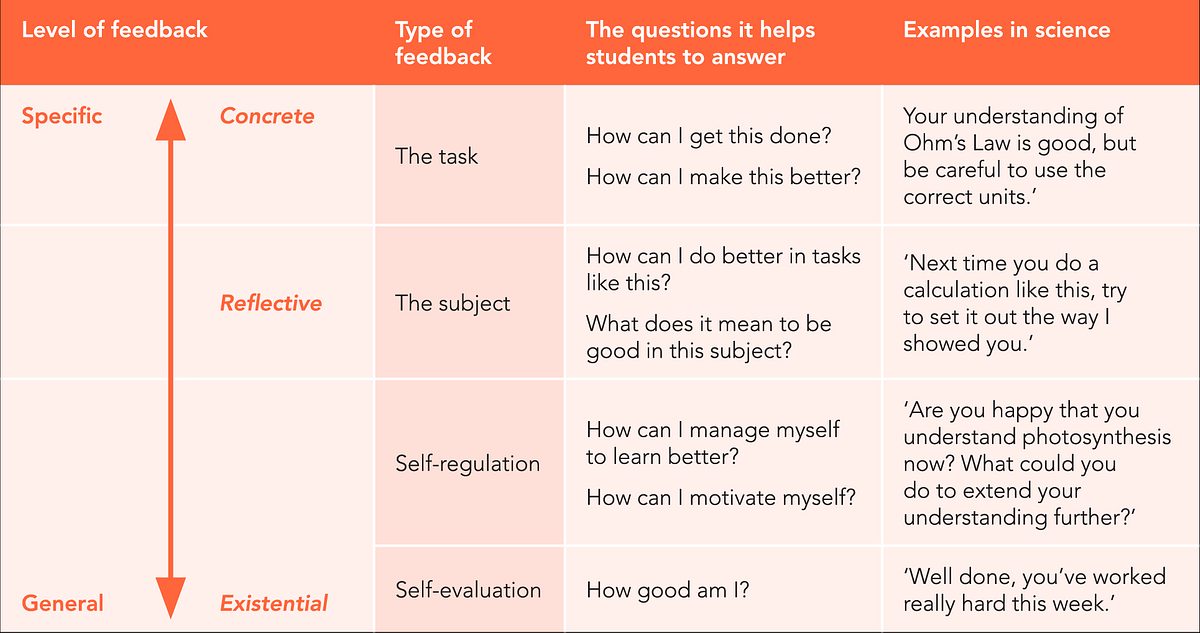The focus of this article is on feedback to learners – that is, information given to a learner about their performance relative to learning goals that is aimed at improving learning. Feedback:
- redirects or refocuses the student’s actions to achieve a goal, by aligning effort and activity with an outcome;
- focuses on an output, process, self-regulation, or self-evaluation;
- can be verbal, written or via digital technology; and
- is provided by a teacher, someone taking a teaching role, or from peers.1
Feedback takes place within the broader context of teaching and learning and can be supported by: high quality initial instruction; formative assessment; addressing misconceptions; knowing students; and a supportive classroom environment.
A focus on feedback is aligned with the Australian Professional Standards for Teachers 1.2 Understand how students learn and 5.2 Provide feedback to students on their learning.
Evidence from the Teaching & Learning Toolkit suggests that the use of feedback has consistently high levels of impact. It can lead to learning gains of +6 months over the course of a year, when used well. The Toolkit evidence on feedback has a high level of security and implementing feedback is relatively low in cost.1
Feedback
The Toolkit highlights that1:
- effective feedback tends to focus on the task, subject and self-regulation strategies;
- studies of verbal feedback show slightly higher impacts overall;
- effects are high across all subjects, with slightly higher effects in mathematics and science;
- feedback has effects across all age groups (slightly greater at primary +7 than secondary +5);
- low achieving students tend to benefit more from explicit feedback; and
- feedback involving metacognitive and self-regulatory approaches may have a greater impact on students experiencing disadvantage.
E4L’s Guidance Reports on metacognition2, science3 and mathematics4,5 draw on extensive reviews of the available evidence to make practical evidence-informed recommendations.
Guidance Reports
Guidance Reports
Guidance Reports
Guidance Reports
The key themes across this guidance that relate to feedback are:
- Focusing on developing the learner
- Quality over quantity
- Opportunities for students to respond
Focusing on developing the learner
Feedback can be more powerful when it focuses on the ‘subject’ and ‘self‐regulation’ levels (see Figure 1 below) – as they help develop the student as a learner.
Focusing on the ‘task’ level is also effective and can be valuable for correcting errors and acknowledging progress but may be less transferable to other tasks.
Feedback at the ‘self‐evaluation’ level is less effective – it may lead students to think that their abilities are fixed which can impact future motivation and effort.

Figure 1: Types of Feedback from E4L's Guidance Report on Improving secondary science
Further considerations for focussing feedback on developing learning include:
- Effective feedback focussed on how students monitor, direct and regulate their own learning forms the basis for successful, independent learning6.
- It is important to give feedback when things are correct – not just when they are incorrect.
Quality over quantity
A smaller amount of high-quality feedback is more likely to have an impact. Key features of quality feedback include:
- it is specific, accurate, and clear;
- makes connections with prior performance; and
- is encouraging and supports further effort.
Further considerations include:
- Form — marks can demotivate low achieving students and can make high achieving students complacent; in contrast, comments can show both how they can do better.
- Efficiency — quality feedback does not need to be onerous or result in high teacher workload. Effective feedback can be given orally to individuals or groups of students during lesson time.
- Who — feedback can come from a variety of sources. Studies have shown positive effects of feedback from teachers and peers.
- Motivation — in motivating students to persevere at challenging tasks, it is important to reward effort rather than absolute levels of achievement; to give feedback about personal progress; and to avoid social comparison.
- Appropriateness — sometimes it may be appropriate to not bring an error to a child’s attention and instead address it through further teaching, examples, or practice.
Opportunities for students to respond
Students do not always understand feedback, or they misunderstand it. Providing students with opportunities to respond to feedback plays an important role in ensuring it improves learning. This can be done effectively by:
- providing guidance on how to respond;
- ensuring that students have enough time to respond to feedback, in lesson or homework time;
- helping students identify things that are hard and require extra effort;
- direct students where to go for help; and
- providing specific guidance on how to improve.
The following vignettes explore what effective feedback practices can look like in maths and science teaching.
Early primary maths
A teacher observes that a student is occasionally skipping some numbers in counting objects. It is clear from observation that they understand one-to-one correspondence. Rather than correct an occasional error, the teacher ensures that they are provided opportunities for further counting practice.
Middle primary science
A number of students are confused about the difference between heat and temperature and are struggling to complete a practical task as a result. Their teacher briefly pauses the experiment for the whole class to provide a clarifying example on the difference between the two concepts, and redirects the steps in the experiment with a more explicit instruction to ‘measure temperature with the thermometer and record it in their logbook’.
Upper primary maths
A teacher observes many students are incorrectly applying the order of operations in a maths practice session. The teacher selects three problems and works through them as teacher-led examples with the whole class. They then ask students to revisit their work in pairs, identifying any incorrect working, and correcting it with a different colour. The teacher actively moves around the class during this process, providing further guidance as required.
Lower secondary science
A teacher notices early in a unit on forces and motion that students are confused about forces acting either by contact or from a distance. They use a brief diagnostic assessment tool to identify students’ misconceptions, followed with targeted instruction, practice opportunities and an understanding-check.
Middle secondary maths
A student is stuck solving a worded problem focussed on algebra. Their teacher prompts them to look at a classroom display that highlights different strategies the class has practiced for approaching problem solving and identify one that could apply to this problem.
Senior secondary science
A senior science teacher notices that students are focussed only on the marks from in-class summative assessments, and the opportunity to further develop their learning was being missed. They develop a protocol for guided peer-marking, with students working in pairs to mark the questions, guided by the teacher and detailed solutions. The teacher takes time to scaffold the process, building student trust and ensuring it is effective and efficient. They provide students with a simple reflection protocol to complete at the end of the marking process, focussed on identifying 1 – 2 pieces of actionable feedback at the task, subject and self-regulation levels.
Scientific investigation
A student has produced a scientific investigation report that is at a lower level than their previous work. Their teacher prompts them to reflect with some questions focussed on: how they approached this task, what they did differently compared to the previous task, and what they might change next time they do a similar task to improve the outcome.
- Is there a clear and shared understanding amongst teachers of what effective feedback looks like in practice?
- Do all teachers have the subject-specific content knowledge necessary to diagnose students’ misconceptions and identify gaps in understanding?
- Are there ineffective feedback practices in place that you may need to consider deliberately de-implementing?
- How are feedback practices and expectations communicated with students, teachers and parents?
- How can classroom instruction and assessment practices support effective feedback?
- What can be put in place to ensure feedback practices are efficient and targeted to have the most impact?
- Feedback to students can have a significant impact on student outcomes
- Effective feedback focuses on developing the learner, prioritises quality over quantity and provides opportunities for students to respond
E4L has a guidance for educators resource focussed on Assessment and feedback in schools.
The Australian Institute for Teaching and School Leadership (AITSL) and Evidence for Learning partnered to produce resources designed to support approaches to enhancing feedback practices.
1 E4L’s Teaching and Learning Toolkit
2 E4L’s Guidance Report on Metacognition
3 E4L’s Guidance Report on Secondary science
4 E4L’s Guidance Report on Mathematics in upper primary and lower secondary
5 E4L’s Guidance Report on Mathematics in the early years with children aged 3 – 7 years
6‘Independent learning’ is when students learn with a degree of autonomy, making active choices to manage and organise their learning, while deploying metacognitive strategies in the process.
